thangka
Handmade Tibetan Thangkas
The Life Of Buddha Narrated In Traditional Thangka Paintings – Part 2
In the first part we described the first four main episodes of the life of Siddharta Gautama.
Following the narration depicted in the beautiful thangka painting realized by our master artists we will explore the events that led the young prince to leave the palace and start his quest for the true meaning of life.
5. The four Encounters.
Having been warned by the court astrologers that his son may well give it all up and choose the path of meditation, Buddha’s father tried his best to shield him from the harsh realities of life.
This state of affairs continued until one day, Siddharta decides to leave the palace with one of his servants driving the chariot.
During his journey the prince encounters an old man, a sick man and a dead man leading to great turbulence in his mind.
He also comes across an ascetic monk and after questioning him Gautama decides to follow his example, convinced that herein lay the way to quell his mental agitation.
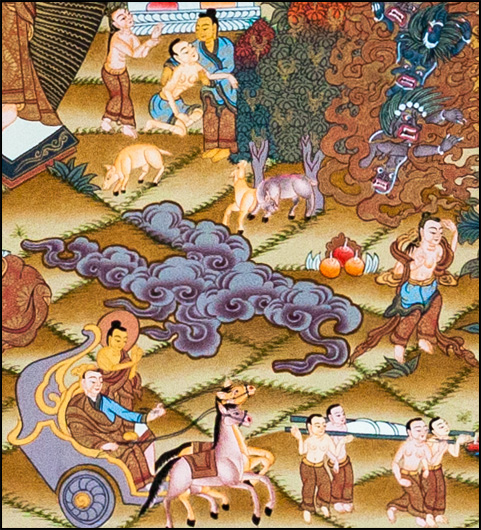
Buddha’s encounters out of the palace
Having made the decision, Siddhartha leaves the palace to pursue his quest and find the truth about life, suffering and genuine happiness.
6. Siddharta leaves the palace and starts his ascetic experience.
According to the legend Gautama left the luxurious palace of his father in the middle of the night, leaving behind his sleeping wife and son.
The first thing that Siddharta did after leaving his home was to cut his long and beautiful hair. his episode is depicted in the thangka painting in representation of Buddha’s strong commitment.
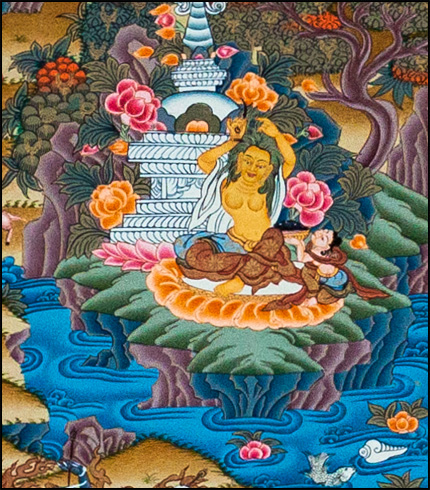
Buddha cuts his hair and starts his ascetic experience
Dressed as a beggar, the young prince wanders from place to place with his begging bowl.
During this time Siddharta encounters several teachers and he learns how to meditate.
Despite what he had learnt he could see that he was still subject to old age, sickness, and death and that his quest was not over.
7. The six years of austerity
Wandering in his search for enlightenment, Buddha came to a pleasant hermitage by a lovely stream where he joined five mendicants practicing a discipline based on severe fasting. The legend says that he ate a single grain of rice for each of the first two years, drank a single drop of water for each of the second two years, and took nothing at all during the last two. For six long years he did these practices becoming so skinny that when he touched his stomach, he could almost feel his spine.
The thangka shows Buddha sitting in lotus position meditating under a tree with his body severely affected by this experience.
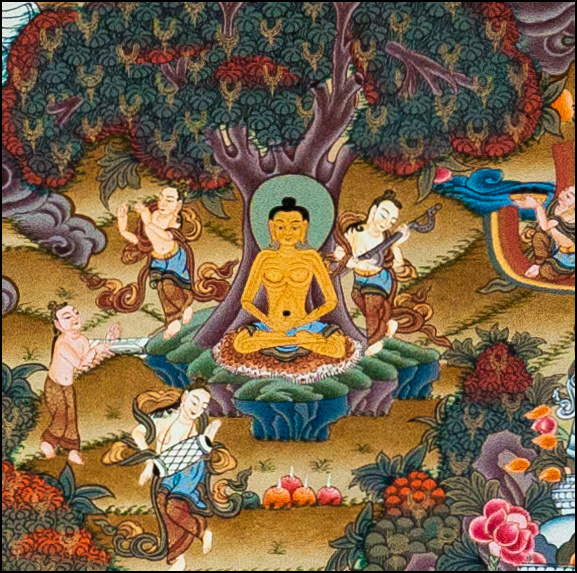
Fasting Buddha in lotus position
In spite of the great pain and suffering Gautama did not find wisdom or the answers to his questions so he decides to go back begging for food and build up his body.
8. Striving for enlightenment
Gautama went to Gaya and looked for a suitable place to sit down and meditate. He found a banyan tree and sat on its east side,
There he met a village girl named Sujata who offered him a bowl of rice. It was the first food he had accepted in years and it instantly restored his body to lustrous good health.
Sujata was so happy and excited that the holy man accepted her food so she starts dancing with joy and comes back in company of her servant with more offering as illustrated in the painting.
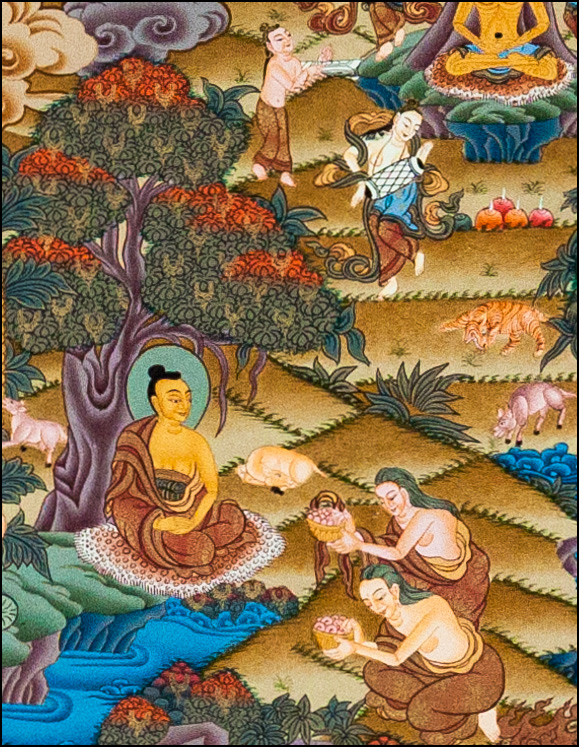
Buddha under the bodhi tree in Gaya
Abandoning himself to meditation, Gautama vowed not to move from that spot until he had attained full enlightenment.
In the third part we will explore the episodes that led Siddhartha to fulfill his search and his commitment to spend the rest of his life teaching others how to achieve enlightenment for themselves.

The Life Of Buddha Narrated In Traditional Thangka Paintings
The thangka paintings of the Life of Buddha narrates the most relevant episodes of the life of Siddhartha known as the “Twelve Great Deeds of the Buddha’s Life”.
These artworks are not meant to be just an illustration of the main events of the historical Buddha, but they are considered to be a visual representation of several philosophical aspects of the Buddhism, especially the progress towards the achievement of spiritual enlightenment.
Using as a reference one of the most beautiful masterpiece in our collection, we will explore in this article the twelve topic events of the life of Siddhartha Gautama that can be divided in three distinct phases:
– His descent on earth, the birth and the young years as a prince.
– The realization of human suffering and his quest for a solution to overcome his suffering.
– The fulfillment of his search and his commitment to spend the rest of his life teaching others how to achieve enlightenment for themselves.
1. Buddha’s promise to descend on earth.
According to the Buddhist cosmogony the universe and all dimensions of the existence are divided in six different realms depicted in another important thangka painting: the Wheel of Life.
Before the Buddha was born into this world as Shakyamuni, he was a bodhisattva in the Tushita heaven, home of the contented gods.
As a prime example of bodhisatva, moved by compassion against the human realm, Buddha decides to manifest himself in this reality with the intention to teach the Dharma and save people from spiritual misery and suffering.
This episode is represented by the Buddha, surrounded by other divinities, making his promise holding a golden bowl (in some cases a lotus flower) symbol of the purity of his intention.
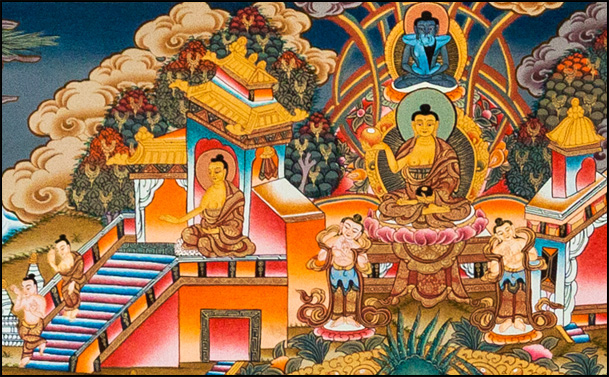
Buddha in heaven and his descent on earth
Thus, Buddha, looking down upon the sentient beings suffering and, in accordance with his bodhisattva status, decided to descend to the earth and spread the word of Dharma.
2. Mayadevi’s Dream.
Buddha’s descent to this world is represented by his mother, the princess Maya Devi, dreaming a white elephant.
The legend says that during one night of full moon, Maya Devi dreamed to be taken by four devas (spirits) to a lake in the Himalaya. There she encountered a white elephant that ripped the right side of her belly with his tusks.
Finally the elephant disappeared and the queen awoke, knowing that she had been delivered an important message, as the elephant is a symbol of greatness in Nepal.
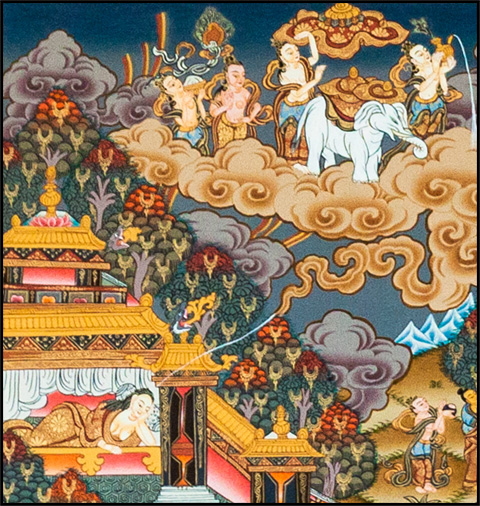
Princess Mayadevi dreaming the white elephant
The elephant is also symbol of strength and intelligence and his color is associated to the gray clouds that carry the rain able to give life to the soil. So the white elephant, in this allegory, is an emblem of fertility and at same time of immaculacy.
3. The Birth of Buddha.
After ten months of pregnancy Maya Devi went to her father’s kingdom and deliver the baby with the assistance of her mother. However on the way to her childhood home, she decides to stop in a beautiful garden in Lumbini and take a rest underneath a blossoming sala tree.
The story says that Buddha was born from her mother’s right side while she was standing grasping a branch of the tree.
This peculiar position assumed by Maya Devi influenced the female iconography all over Asia. The sinuous gesture is been adopted by traditional dance choreographic and inspired several generations of artists.
The depiction of the event also shows the presence of the Hindu gods Indra and Brahma at the time of birth.
Buddha was immediately able to walk. In fact he took seven steps forward and at each step a lotus flower appeared on the ground.
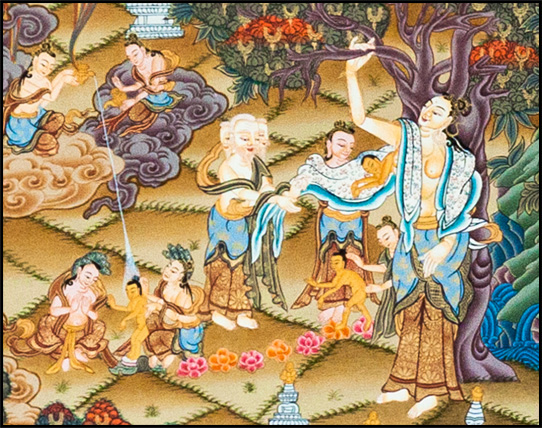
The birth of Buddha
He was named Siddhartha Gautama. In Sanskrit Siddhartha means ” the One who achieves his goal”.
The princess Maya Devi will die seven days after Buddha was born.
4. Buddha’s early years and his wordly life.
Little is known about the early life of prince Siddhartha.
Because his father had been warned that the boy might abandon his palace and his royal destiny to follow a spiritual path, the young Siddhartha lived a comfortable and sheltered life. He received the finest education and mastered all lessons taught to him. In his younger years he also excelled in sports, particularly riding the horse and with the bow.
He had the reputation to be also physically extraordinary attractive.
When he came of age and assumed royal duties, prince Siddhartha became a true man of the world and had a retinue of many queens and attendant ladies.
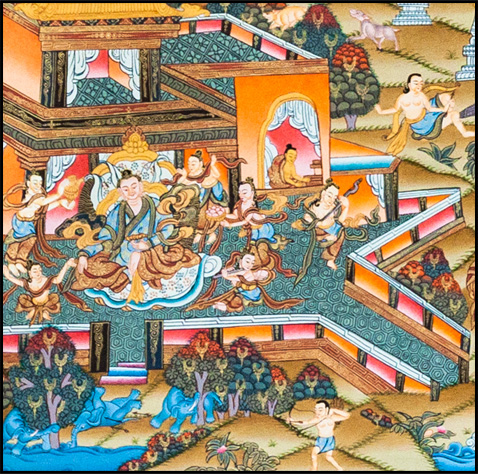
Young prince Siddhartha in the palace
In the second part we explore the episodes that led Siddhartha to start his ascetic life and his quest for a solution to human suffering.

The Thangkas of The Tibetan Medicine
Created between 1687 and 1703, these thangka paintings were commissioned by the fifth Dalai Lama’s regent, Desi Sangye Gyatso, who stepped in as interim ruler of Tibet after the Dalai Lama died in 1682.
The paintings constitute the charts of The Blue Beryl, a text written by Gyatso as commentary of the Four Tantras, the fundamental text of Tibetan medicine.
The main reason that moved Gyatso to create this illustrations was to avoid confusion when interpreting old texts.
Gyatso placed great value on the accuracy of the illustrations depicting such things as the use of omens and dreams for making diagnoses, hundreds of medicinal herbs and medical instruments, and fabulous diagrams of human anatomy.
As stated by the International Academy for Traditional Tibetan Medicine (IATTM) “one of the unique features of Traditional Tibetan Medicine is that it contains a comprehensive philosophy, cosmology, and system of subtle anatomy with associated spiritual practices”.
Today these Thangkas constitute a fundamental piece of educational art that interweave Tibetan Buddhist traditions with centuries-old medical knowledge.
The first painting occupies a privileged place among the others which, in a certain sense, derive from it. It represents the celestial city of the Buddha Bhaisajyaguru, Master of Remedies “Surdasana”. The city is surrounded by four “mountains”. Further more it is square with the palace at its center. The palace, like the whole locality, is an emanation of Buddha Bhaisajyaguru. Its plan evokes a Mandala, with its square enclosure and its four gates oriented in the cardinal directions.
The thangkas not only depict the Buddhist background of Tibetan medicine but also the diagnostic schemes of pulse and urine analysis, picturesque representations of dietary and behavioral advice for treating illnesses, as well as anatomical knowledge,charts for moxabustion, and the elaborate “materia medica” of Tibetan pharmacology.
In fact Twenty-one Thangkas of the original series are devoted to more large human figures illustrating anatomical structures.
The first fifteen compositions have a top register. The registers contain the four main sequential topics relating to the origin myths and state narrative on the Tibetan History of Medicine of the late 17th century.
There are four main sequential topics contained in the registers:
– Medicine Buddha and early Indian Gods and Rishis.
– The Lineage of the Four Medical Tantras.
– The Yutog Nyingtig Lineage.
– The Deities and Protectors of the Yutog Nyingtig.

Follow traditionalartofnepal.com on WordPress.com
Raktayamari Thangka: A Closer Look at the Thangka Worth $45 Million
Overlook
Widely recognised as one of the most important Asian works of art and one of the world’s great textile treasures, this Thangka was recently bought for $45 million.
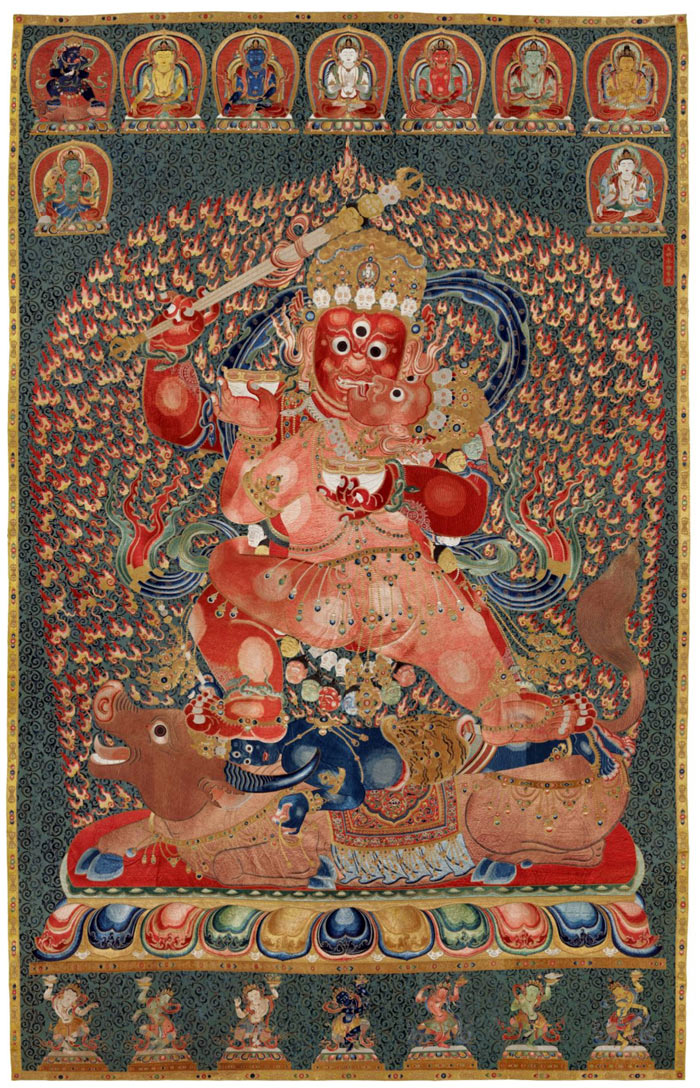
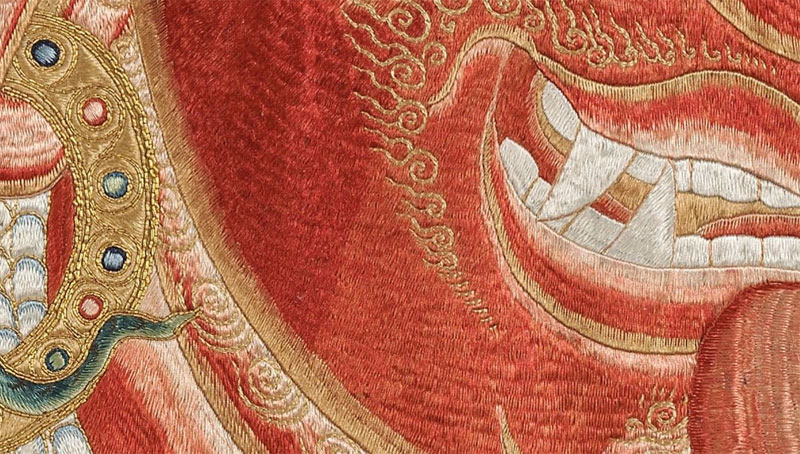
The Thangka depicts the majestic Raktayamari, the red Conqueror of Death, standing in yab-yum embracing his consort, Vajravetali.
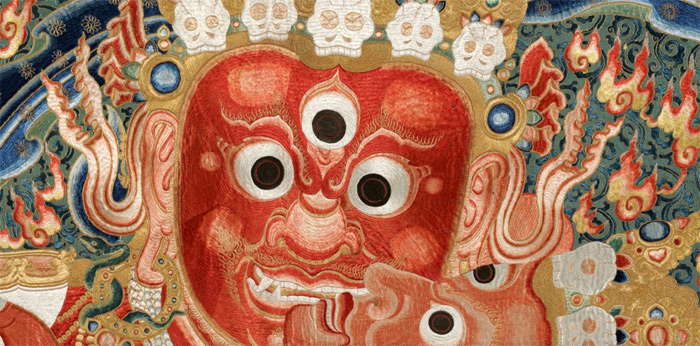
Raktayamari is an important deity of Anuttarayoga-Tantra in Vajrayana Buddhism, and one of the three Yamari forms of Bodhisattva Manjusri (the other two being Vajrabhairava and Krishna-Yamari) revered by various Tibetan sects.
The highlights on the torsos and limbs of Raktayamari and Vajravetali, to denote the musculature, are some of the most common motifs in Nepalese-Tibetan paintings and a notable characteristic of figures in classical Tibetan art.
Highlights and Symbolism
Every aspect of the form of Yamari and the consort Vajra Vetali have symbolic and coded meaning.
The red body color represents the desire to overcome all sufferings and place all beings in the state of enlightenment. The weapon that Raktayamari holds subdues the afflictions (maras).
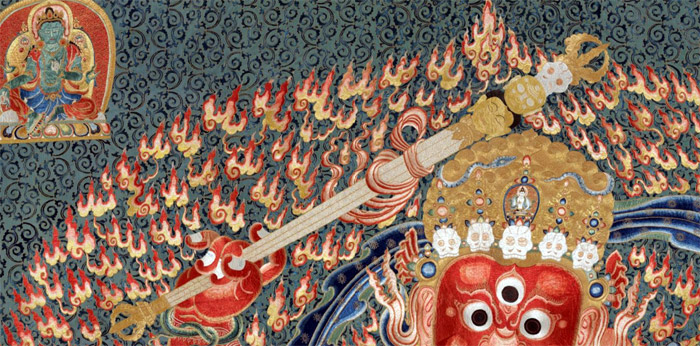
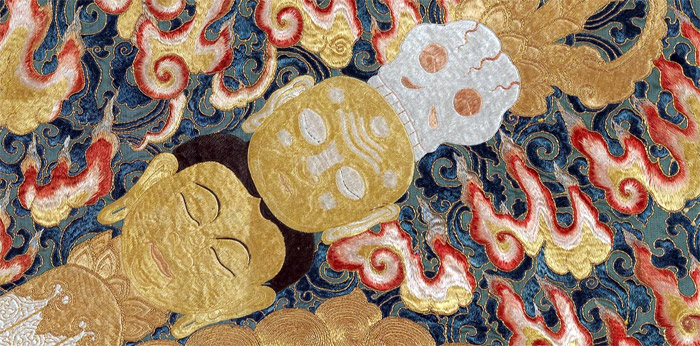
The left hand holds a cup made by ancient Lama’s skull and containing the essence of the four maras transformed.
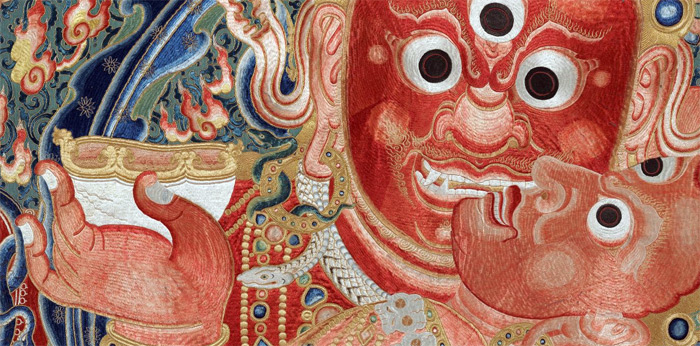
The three round eyes express compassion for all beings in the three times of past, present and future as well as the three watches of the day and three watches of the night.
The orange and red hair is to symbolize the increasing qualities of the Buddha and the aspects of the Mahayana Five Paths.
The crown of five dry skulls symbolizes the five poisons transformed into the five wisdoms.
The necklace of fifty fresh heads represents the vowels and consonants of the Sanskrit language.
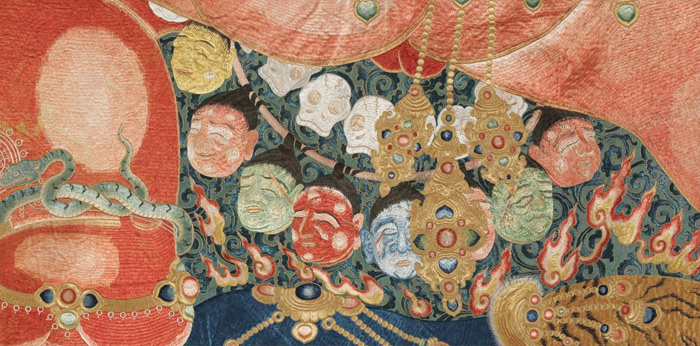
The eight snakes represent the subjugation of various obstacles and the accomplishment of skillful activities.
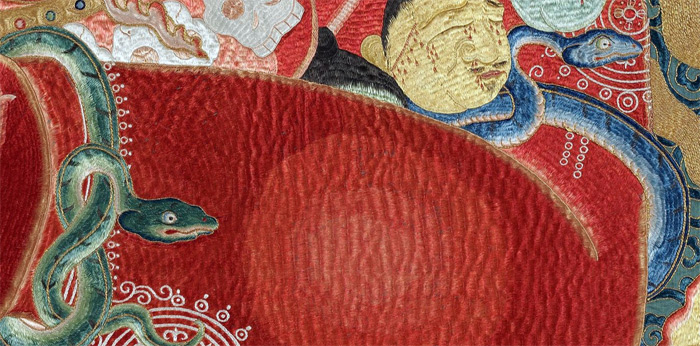
The locked couple is trampling on the blue corpse of Yama, the Lord of death, wearing a tiger skin and crown, lying on the back of their mount, a brown buffalo recumbent on a multi-coloured lotus base.
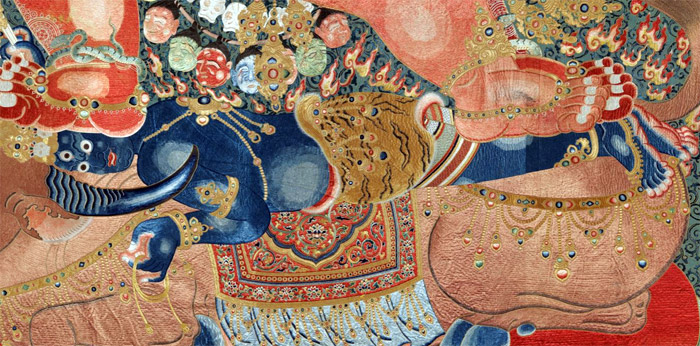
All below two rows of buddhas and bodhisattvas seated on lotus bases, the upper including Heruka Vajrabhairava on the far left and Manjusri on the far right, flanking the five Dhyani Buddhas.

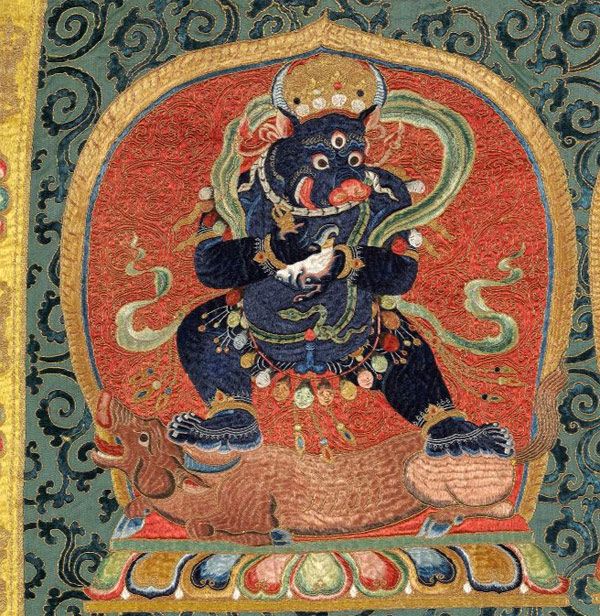
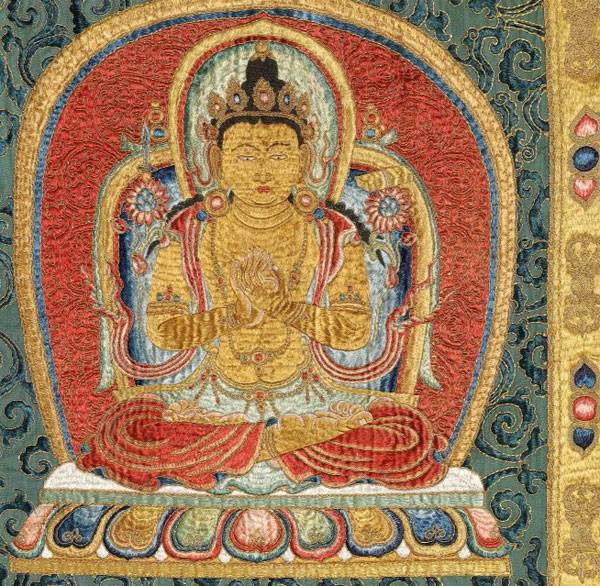
Below this row of deities are two Taras – Green Tara on the left, and White Tara on the right.
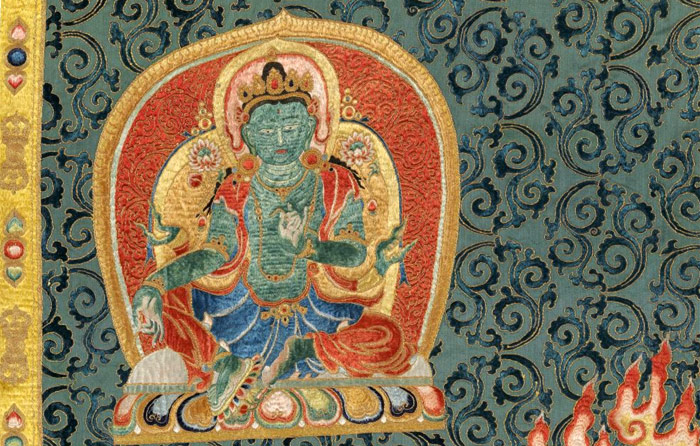
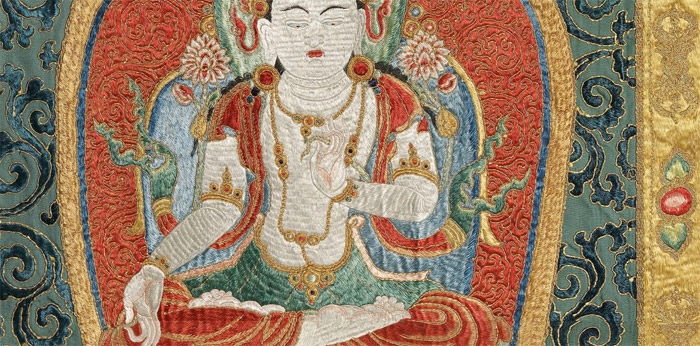
In the lower panel is a row of seven offering goddesses dancing on lotus bases and holding aloft dishes as offerings below the couple.
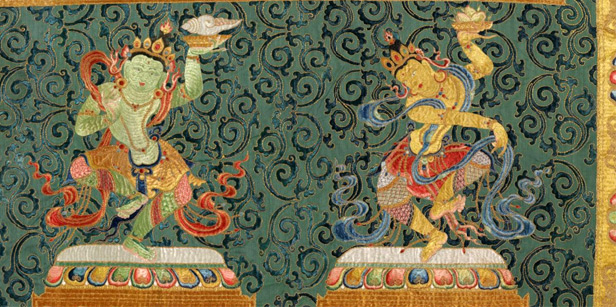
Meaning of the artwork
The metaphor for Rakta Yamari is ‘death.’ The name means the ‘Red Killer of Death.’
In this symbolic meaning the idea of death refers directly to the suffering and unhappiness in the world as described in Buddhist philosophy.
The general appearance of the deity, number of faces, arms, ornaments, decorations and attributes are all part of a mnemonic device (memory system) that incorporates the most essential of Buddhist principles and core teachings into a single object.
The one face represents the embodiment of the wisdom of all Buddhas as having one taste, or flavor, ultimate truth. The red body color represents the desire to overcome all “maras” and place all beings in the state of enlightenment.
Bibilography
Henss, Michael. ‘The Woven Image: Tibeto-Chinese Textile Thangkas of the Yuan and Early Ming Dynatsies’, Orientations, November 1997.
Himalayan Art Resources. Rakta Yamari Main Page. http://www.himalayanart.org/search/set.cfm?setID=349. Jeff Watt, 2-2005.
Himalayan Art Resources. Rakta Yamari Textile. HAR no. 57041. http://www.himalayanart.org/image.cfm/57041.html.
Raktayamari-tantraraja-nama. Gshin rje’i gshed dmar po zhes bya ba’i rgyud kyi rgyal po [TBRC w25383, w25384].
Reynolds, Valrae, ‘Buddhist Silk Textiles: Evidence for Patronage and Ritual Practice in China and Tibet.’ Orientations, April 1997.
George Roerich (trans.), Biography of Dharmasvamin, A Tibetan Monk Pilgrim. Patna: K.P. Jayaswal Research Institute, 1959.
George Roerich (trans.), The Blue Annals. Delhi: Motilal Banarsidas, 1996, 2nd ed.

Follow traditionalartofnepal.com on WordPress.com
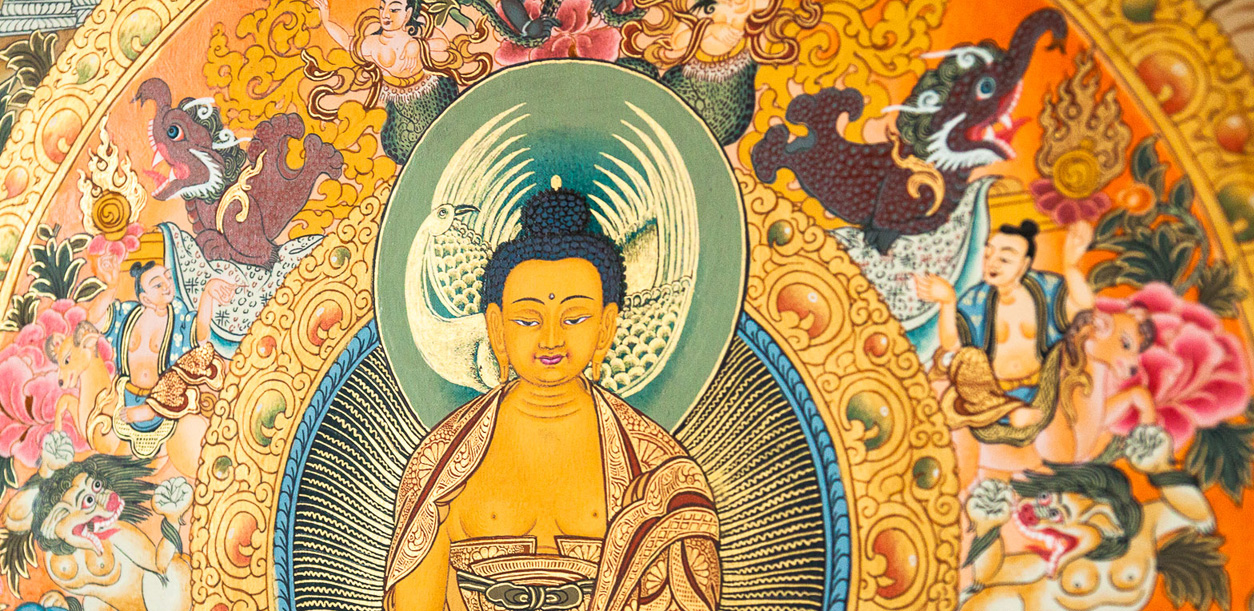
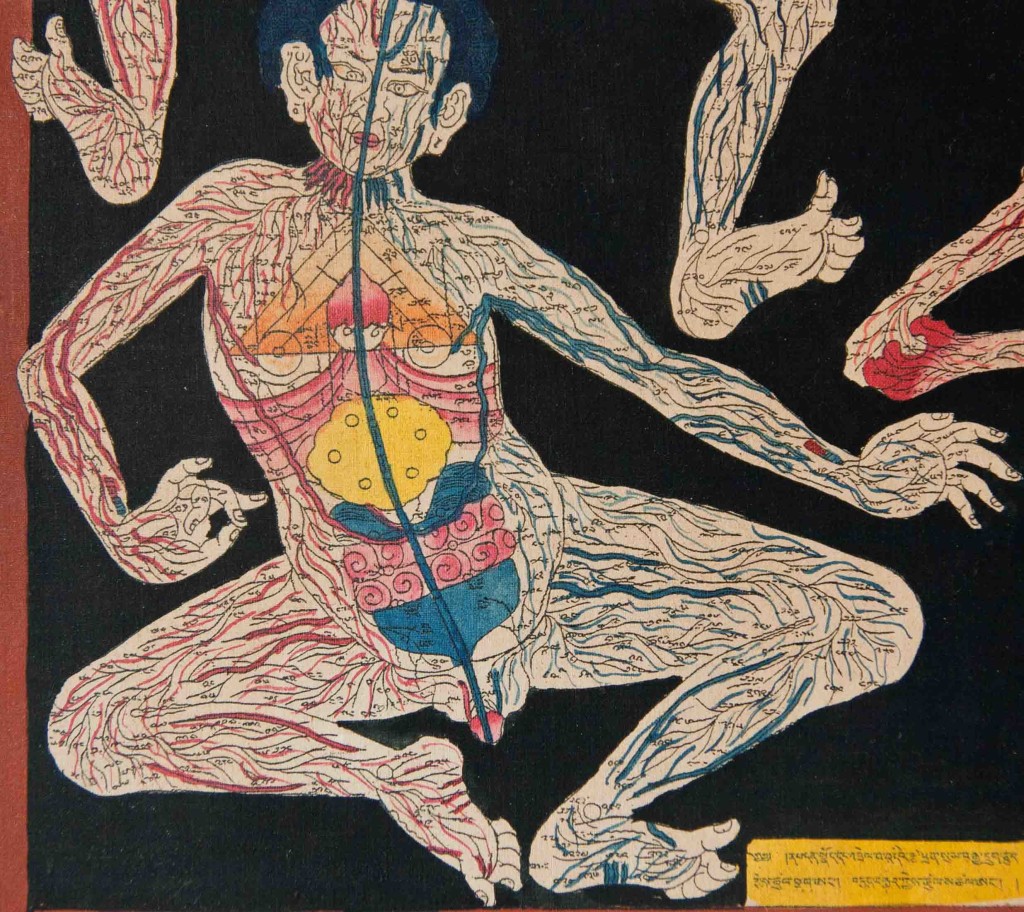
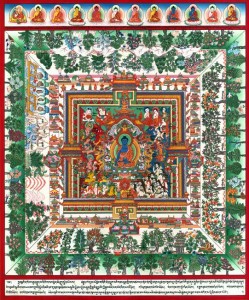
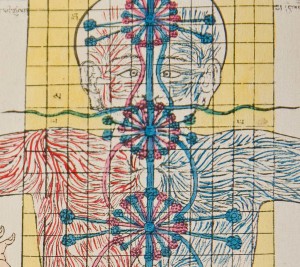
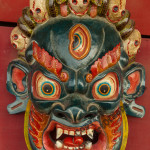 Wrathful Bhairava Mask
Wrathful Bhairava Mask 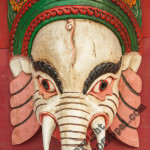 Ganesh Mask Design #02
Ganesh Mask Design #02 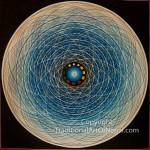 Universe Om Mandala
Universe Om Mandala 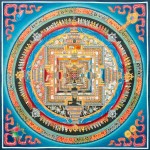 Kalachakra Mandala Auspicious Symbols
Kalachakra Mandala Auspicious Symbols 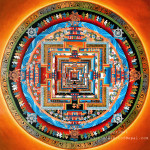 Kalachakra Mandala
Kalachakra Mandala 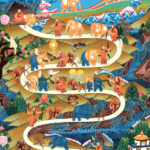 Samatha Meditation Thangka
Samatha Meditation Thangka 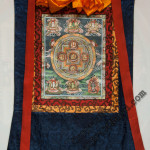 Silk Frame #02
Silk Frame #02 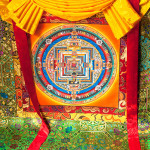 Modern Design Brocades
Modern Design Brocades 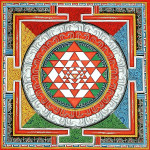 Sri Yantra Mandala
Sri Yantra Mandala 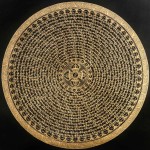 Yin Yang Mantra Mandala
Yin Yang Mantra Mandala 





